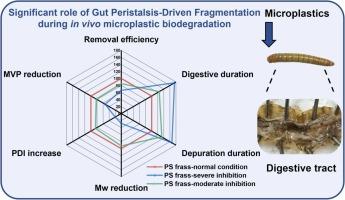被忽视的肠蠕动驱动的微塑料肠道碎片化的作用
IF 11.3
1区 环境科学与生态学
Q1 ENGINEERING, ENVIRONMENTAL
引用次数: 0
摘要
可塑性昆虫及其降解塑料的肠道菌群对微塑料的降解引起了人们的广泛关注。然而,肠道破碎能力对塑性动物体内MP降解过程的贡献仍然知之甚少。在这里,我们首次研究了蠕动驱动的肠道碎片在模型可塑性虫黄粉虫幼虫消化清除、生物降解和MPs尺寸减小中的作用。我们的研究结果表明,蠕动驱动的碎片对于降解和推进可塑性T. molitor幼虫内的MPs都是必不可少的。当肠道蠕动抑制剂浓度分别为5%和2% (wt/wt)时,严重或中度抑制肠道碎裂,MP清除效率分别从正常条件下的59.81%显著下降到39.58%和51.06%,并伴有MP在肠道中的滞留时间延长。重要的是,破碎受损直接限制了解聚效率,生物降解后残留聚合物的分子量更高。超灵敏颗粒分析进一步表明,抑制蠕动驱动的破碎导致未消化的较大尺寸的塑料颗粒排泄。此外,在抑制条件下,最小的未消化颗粒甚至更小,可能是由于减少了表面磨损。这些发现强调了以前被低估的蠕动驱动的碎片功能在促进可塑性无脊椎动物MP生物降解中的作用。本文章由计算机程序翻译,如有差异,请以英文原文为准。

Overlooked Role of Peristalsis-Driven Gut Fragmentation of Microplastics by Plastivore Tenebrio molitor Larvae
Microplastic (MP) degradation by plastivore insects and their plastic-degrading gut microbiota has attracted significant attention. However, the contribution of intestinal fragmentation capacity to in vivo MP degradation processes in plastivores remains poorly understood. Here, we investigate, for the first time, the role of peristalsis-driven gut fragmentation in the digestive removal, biodegradation, and size reduction of MPs by the model plastivore Tenebrio molitor larvae. Our findings demonstrate that peristalsis-driven fragmentation is essential for both degrading and propelling MPs within the plastivore T. molitor larvae. When intestinal fragmentation was either severely or moderately inhibited with 5% and 2% (wt/wt) concentrations of gut peristalsis inhibitors, MP removal efficiency significantly decreased from 59.81% under normal conditions to 39.58% and 51.06%, respectively, accompanied by prolonged retention of MPs in the gut. Importantly, impaired fragmentation directly limited depolymerization efficiency, as evidenced by higher molecular weights of residual polymers post-biodegradation. Ultrasensitive particle analysis further demonstrated that the inhibition of peristalsis-driven fragmentation resulted in the excretion of undigested plastic particles of larger sizes. Additionally, under inhibitory conditions, the smallest undigested particles were even smaller, likely due to reduced surface abrasion. These findings highlight the previously underappreciated role of peristalsis-driven fragmentation function in facilitating MP biodegradation in plastivore invertebrates.
求助全文
通过发布文献求助,成功后即可免费获取论文全文。
去求助
来源期刊

Journal of Hazardous Materials
工程技术-工程:环境
CiteScore
25.40
自引率
5.90%
发文量
3059
审稿时长
58 days
期刊介绍:
The Journal of Hazardous Materials serves as a global platform for promoting cutting-edge research in the field of Environmental Science and Engineering. Our publication features a wide range of articles, including full-length research papers, review articles, and perspectives, with the aim of enhancing our understanding of the dangers and risks associated with various materials concerning public health and the environment. It is important to note that the term "environmental contaminants" refers specifically to substances that pose hazardous effects through contamination, while excluding those that do not have such impacts on the environment or human health. Moreover, we emphasize the distinction between wastes and hazardous materials in order to provide further clarity on the scope of the journal. We have a keen interest in exploring specific compounds and microbial agents that have adverse effects on the environment.
 求助内容:
求助内容: 应助结果提醒方式:
应助结果提醒方式:


